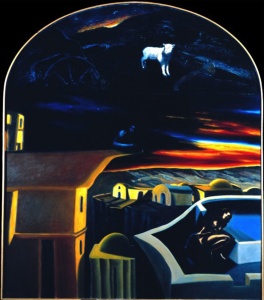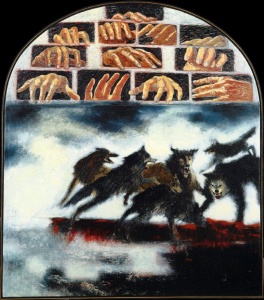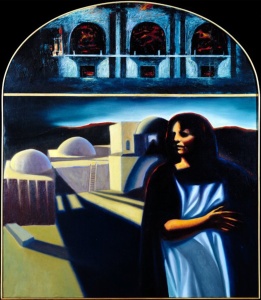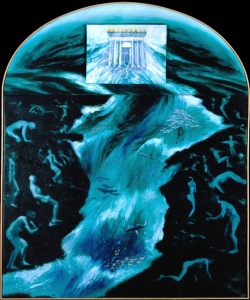36 Paintings
Janet Shafner is one of the most exciting and intelligent painters I have come across in many years. As an observant Jewish artist she has chosen Tanach, Midrash, Talmud and its commentaries as her inspiration and subject matter. In crafting her complex images she utilizes a talmudic visual paradigm offering midrashic and/or modern images as a kind of “counter text” that contrasts with her biblical depiction that forms the main visual “text” of most works.
Many of her exegetical observations liberate the plain meaning of the narratives and thus assume startling contemporary meanings. This exhibition is a truly ground breaking event in Jewish art because Shafner sees the biblical in creative tension with contemporary thought. Thirty-six of her paintings from the last fifteen years will be on view until June 8 at the Lyman Allyn Art Museum in New London, Connecticut.
Shafner’s use of this talmudic paradigm is inherently critical and analytical, producing a rare combination of visual excitement and intellectual stimulation that frequently explores subjects concerning women. While she is especially interested in women who take destiny into their own hands or whose role, even as victims, becomes pivotal, she is not a strident feminist and always creates art that delves into the manifold meanings of each subject.

In David and Bathsheva (1997) the complexity of the subject is immediately apparent in the maze-like depiction of Jerusalem with Bathsheva seen cowering in the lower right. David is barely visible in the blue shadows at the exact center of the painting. He seems suspended, as it were, between his desires and his role as the anointed of God. Bathsheva glances up at a forlorn lamb in the lunette above.
Shafner attaches a lunette (a half moon shaped canvas) to the top of her paintings so that this area functions like the Rashi or Tosafos on the talmudic page, commenting on or explicating the central image. The lamb, standing pristine white in a devastated modern battlefield, represents the parable told by Nathan the prophet after the death of Uriah (engineered by David to secure Bathsheva as his wife). He has acted like a greedy rich man despoiling the poor man’s only lamb. David’s injustice stains his entire reign with bloodshed.
God punishes David by causing the son Bathsheva bore him to die. The painting comments by positioning the lamb centrally above the lower panel implying that God’s stern justice falls equally upon the innocent Bathsheva as well as the guilty David. When evil is done in the eyes of Hashem the consequences are awesome for all concerned, whether in David’s time or our own.

Consequences are of special concern to Janet Shafner. One subject she examines in a series of three paintings, The Concubine of Gibeah (1998-1999) is perhaps the most sordid tale in all of Tanach. Three chapters of Judges (19, 20, 21) detail the story of a concubine of a Levite who ran away and was retrieved from her father’s house. Returning home he needed to seek shelter in the Benjaminite town of Gibeah. A gang of townsmen attempted to rape the Levite guest, but his concubine was sent out to them instead. She was gang raped all night and died as a result. In a distracted fury the husband dismembered her body into twelve parts and sent them to all the tribes demanding that they exact justice from the recalcitrant town of Gibeah.
As a result of this atrocity all the tribes descended upon the tribe of Benjamin and terrible bloodshed ensues, practically causing the complete decimation of the tribe of Benjamin. The section begins and ends with the verse, “In those days there was no king in Israel.” The final words of the Book of Judges comments that “a man would do whatever seemed proper in his eyes.” Irresponsible passions lead to unspeakable crime and retributions escalate into anarchy.
In Shafner’s painting Jacob’s final blessings to his troublesome sons at the end of Genesis provide a startling perspective to this tale. “Benjamin is a predatory wolf; in the morning he will devour prey and in the evening he will distribute spoils.” Saul the Benjaminite is a fearless wolf-like warrior defeating the Moabites, the Edomites and the Philistines. However another aspect of Jacob’s premonition emerges in the account of the animalistic ravishing of the concubine. In her vivid painting agitated brushwork depicts a savage wolf pack seen in its blood frenzy presided over by a chorus of a twelve hands blessing. The shocking image drives home the reality that Jacob’s blessings were not necessarily brochos but rather divinely inspired visions of an uncertain and dangerous future. Shafner’s paintings are an unflinching criticism of the dark side of the human soul found all too often in history, and as recently seen in the mass rapes and ethnic wars in Bosnia.
Jewish texts are the foundation that Shafner builds upon as she structures each painting. Her painting technique is usually a kind of matter-of-fact realism that allows the narrative to predominate, while strong primary colors and dramatic lighting drive home her personal point of view. Next to each work is a text panel that cites the references necessary to understand the image. Shafner understands that the viewers may need more than a simple title to guide them through the complex visual references she embeds in her images. Additionally she has provided a set of commentaries from the local viewing public displayed in the middle of each gallery thereby adding as many voices to the dialogue as is possible.

Future vision is one of Shafner’s preoccupations. Timna (2001) weaves the texts of Genesis, Chronicles, Megillah Esther and the Talmud together into a frightening vision of our times that cries out for compassion and understanding to all those who would support the Jewish people.
Timna’s voice echoes loud and clear from the distant past. As a granddaughter of Esau she wished to join the tribe of Abraham but was inexplicably rebuffed. Their error in judgment had disastrous consequences for the Jewish people. Thus spurned she fell back into her poisonous family and became the concubine of Eliphaz, her own brother, and bore the evil Amalek. The acidic image of this painting shows her rejected, glancing back at the Abrahamic compound. Above the main painting is an image of the ovens at Auschwitz, the legacy of Amalek found in Hitler. The painting is full of long cast shadows, intimating how far into the future actions cast their effects.

Shafner’s paintings include a multitude of unexpected visions. In Ezekiel’s Vision (2000) a landscape takes on prophetic ramifications. A powerful rushing river divides the painting, each bank alive with figures emerging from the earth as the Jewish nation is reborn. This vision of the resuscitation of our people can only occur in the context of its spiritual goal. Cubit by cubit Ezekiel describes the Third Temple and Shafner depicts this Temple here in a brilliant white square in the lunette above. Jumping ten chapters ahead to the very end of the prophet’s vision the roaring river is teeming with fish as the waters flow forth from the miraculous Temple to sustain the entire earth with its abundance. Shafner has expertly negotiated the disparate sections of this difficult and mystical prophecy and presents us with a cogent vision of the Jewish future.
Janet Shafner has created paintings and taught art her entire life remaining immersed in the contemporary art world of modernism and postmodernism. That background, fused with her lifelong love of medieval religious paintings, produced an artistic sensibility well suited to approach the complexities of Jewish subject matter. What is unique about her work is that the aesthetic sensibility of a lifetime of making art has been joined to a singular talmudic paradigm of deriving meaning. Shafner discovers her meanings in the difficult encounter of the biblical with the contemporary world and its values. The critical edge found in her paintings reflects a rigorous approach to learning Torah that does not flinch from asking the hard questions and, perhaps more importantly, facing the equally difficult answers the paintings imply. Jewish art, at its best, is a double-edged sword. It can transform the contemporary world with a Torah that seems fresh and new on each canvas.
An excellent catalogue of the exhibition with color reproductions of all works is available from Jewish Heritage Project: 800 428 9918.
Published in The Jewish Press